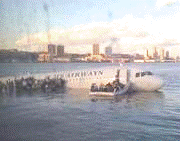Bird Strike Committee Proceedings

Bird Strike Committee-USA/Canada Joint Annual Meeting: 10th (2008)
Date of this Version
8-2008
Document Type
Article
Abstract
It is estimated that the recorded civil wildlife/ aircraft strikes (73,526) from 1990- 2006 represent <20% of their true occurrence and that the cost incurred by the US civil aviation industry exceeds $600 million annually. Twenty-eight percent (16,142) of identifiable strikes that occurred during this time (58,060) were documented by airport personnel and 73% of all reported strikes occurred at or below 500 feet (i.e., typically within the airport environment). It should follow that properly trained airport personnel could make a difference. To reduce aviation/ wildlife conflicts, these personnel attend training seminars to better understand a diversity of subjects such as wildlife threats, mitigation techniques, documentation procedures and regulations. Although the FAA has standardized the basic information to be provided within this training (Advisory Circular No: 150/ 5200-36), its content should be considered malleable from region to region and year to year. In FY-2006, USDA Wildlife Services personnel assisted 674 civilian and military facilities (civilian = 502; military/ civilian joint = 101; military = 71). Wildlife Services provided both operational and technical assistance to 271 and 403 airports respectively; resulting in 1,739 trained personnel from 217 civilian and military airports. During 2006 the WS North Carolina Program implemented an extensive, hands-on training program to assist military, General Aviation and 139 certificated airports to better understand wildlife hazards to aviation and meet FAA Advisory Circular 150/ 5200-36 requirements. Two hundred airport personnel were trained in North Carolina using nationally developed training modules. Because an airports personnel and wildlife concerns are dynamic, training techniques and content should be constantly evaluated and modified. Updated training seminars and modules should be made readily available to all instructors while techniques to quantify the impact of this training should be considered.


Comments
Abstract of paper presented at Bird Strike Committee USA/Canada Meeting, Lake Mary and Sanford, Florida, August 18–21, 2008.